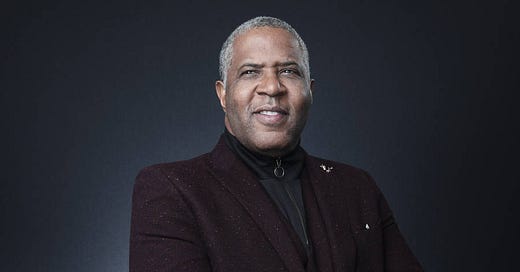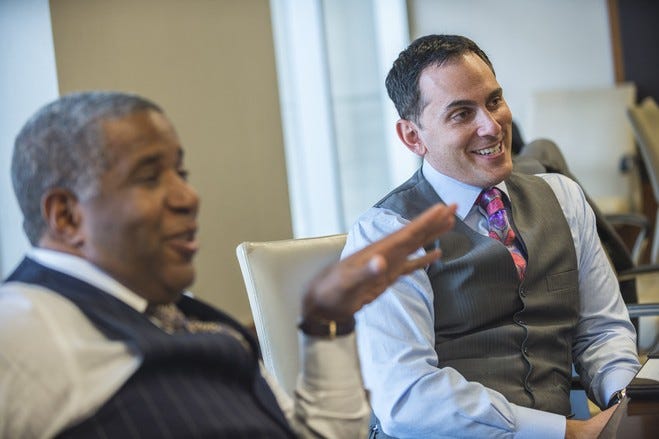Billionaire’s Secret Buyout Formula
Robert Smith’s private-equity firm revamps software companies by following detailed protocols; ‘their process is like a factory’
Billionaire investor Robert Smith believes corporate buyouts can be reduced to a formula. His private-equity firm, Vista Equity Partners, has codified that notion into 110 acronym-heavy directives known as Vista Best Practices. They are secret—stored on a company server that makes a record every time anyone downloads or prints them.
Target companies must have “critical factors for success,” or CFS, within their control. Employees of acquired companies and candidates for hiring must submit to tests. A personality test aims to determine which of them are suited to which jobs. Salespeople are better off being extroverted, and software developers more introverted. A proprietary cognitive assessment, similar to an IQ test, includes questions on logic, pattern recognition, vocabulary, sentence completion and math. The test inspires consternation and fear among existing employees, according to former employees. Vista primarily hires job applicants who do well, often young people with modest credentials or experience. These are its “high performing entry-level” workers, or HPELs.
The goal of the Austin, Texas-based firm, which is 18 years old, is to transform business-software companies into profit machines. Behind its approach is Mr. Smith’s belief that certain aspects of the companies Vista buys are interchangeable. “Software companies taste like chicken,” he said at a conference in New York a few years ago. “They’re selling different products, but 80% of what they do is pretty much the same.” Derek Jones, managing director at longtime Vista investor Grosvenor Capital Management, says “their process is like a factory. A deal comes in and it gets compartmentalized, and they apply experts on each compartment. After it goes off the assembly line, the margins are higher.”
Vista, which has done more than 300 deals, tells investors it has never lost money on a buyout—notable in an industry known for big hits and misses. Its largest fund has consistently been in the top quartile of comparable funds formed the same year, measured by annualized returns after fees, according to data provider Preqin. It now manages more than $31 billion, up from just $7 billion five years ago. The ultimate gauge of success for any private-equity firm, however, is the price at which it cashes out of its investments. Vista has yet to unload some of its biggest bets, and has never completed an initial public offering for a portfolio company—an avenue used frequently by other buyout firms to dispose of assets.
Still, its success has made Mr. Smith, Vista’s 55-year-old founder and chief executive, the richest African-American in the U.S., ahead of Oprah Winfrey, with a net worth of $4.4 billion, according to Forbes. He owns a $59 million penthouse in Manhattan and a $19.5 million mansion in Malibu, among other properties. In 2015, he wed a former Playboy playmate of the year. He is chairman of Carnegie Hall and has donated tens of millions of dollars to cultural institutions and social causes. Mr. Smith has kept the details of his firm’s methods largely secret. The Wall Street Journal discussed some of them in interviews with investors, former employees of the firm and its portfolio companies, and other people familiar with its business model. A Vista spokesman declined to make Mr. Smith or other Vista executives available for interviews, citing a policy of not commenting during fundraising periods. Vista is currently trying to raise $12 billion for a new buyout fund.
Mr. Smith, the son of two high-school principals, grew up in Denver and studied chemical engineering at Cornell University. He worked as a chemical engineer at several companies, including Kraft General Foods, then attended Columbia Business School. In 1994, he joined Goldman Sachs Group Inc. as a mergers-and-acquisitions banker. At Goldman, he worked with Houston auto-dealership-software maker Universal Computer Systems Inc. He eventually persuaded its founder, Robert Brockman, to buy other business-software companies and improve them using Universal’s operating principles. In 2000, after a Brockman family charitable trust agreed to commit $1 billion in two phases, Mr. Smith started Vista with co-founder Brian Sheth, now the firm’s president, and another co-founder who has since left the firm.
Private-equity firms typically buy companies using money invested by their founders, institutional investors such as pension funds, and others, amplifying their bets with borrowed money. Their goal is to sell the companies later at a profit. When Vista began, investors were wary of software businesses taking on debt, because they had few hard assets. Vista helped persuade them that companies with subscription-based businesses can tolerate debt. “Robert, over time, convinced an entire market to see this cash-flow stream of software revenue as a reliable annuity that could be financed with debt,” says Gregg Lemkau, co-head of Goldman’s investment banking division, who worked with Mr. Smith before he founded Vista.
Before it buys a company, Vista evaluates whether its software is “mission critical” and whether it has control over its “critical factors for success,” or the key drivers of its performance. If the answers are yes, Vista often pays what its competitors see as a high price, confident it can boost the company’s profitability through diligent execution of its best practices. Members of the firm’s 100-person Vista Consulting Group, or VCG, then swoop in. Some set to work revamping the company’s contracts and building in automatic price increases and renewals, with the goal of increasing recurring revenue and lowering the risk customers will defect. Vista also overhauls the sales process, encouraging cross-selling of products, through commissions. The process is meticulous, says Art Papas, founder of recruiting-software maker Bullhorn Inc., which Vista bought in 2012.
“It’s not just: ‘Hey, you should have a process for incentivizing sales people,’ ” he says. “It was: ‘Here’s a commission template we’ve built, and it has seven tabs in the spreadsheet, and there are the formulas.’ ” Former employees say cost cutting is critical to Vista’s model. Some of the companies Vista takes over are located in markets with a high cost of living, such as Southern California or New York City. To tamp down wages and other costs, Vista will relocate part or all of the company to a less-expensive city such as Dallas. Many employees won’t make the move, allowing Vista to hire cheaper replacements. Vista often keeps a company’s headquarters in place and encourages it to expand in lower-cost markets.
Most of the people Vista hires score highly on the cognitive test. Often they are young employees with less-impressive credentials or experience. These HPELs, as they are known, may have gone to state universities and be willing to do a job for $75,000 that an Ivy League graduate in a high-cost market would demand twice as much for. Vista takes the tests very seriously, using proctors or observing test-takers by video to make sure no one cheats. The test’s purpose, says an executive at a former Vista portfolio company, is to “level the playing field” among employees. The executive says he told a manager who was upset about having to take it that all of his subordinates would be doing so as well. Former employees say low scorers aren’t fired, but they are less likely to be promoted.
Industry veterans tend to be offended by the requirement. A former sales manager at portfolio company Misys PLC, a banking-software provider now called Finastra, says the test kept him from hiring experienced candidates who received low scores. Instead, he says, he hired younger workers with less experience who were able to score highly on the test because they were recently out of school. Vista touts the tests to its investors as a great equalizer, helping make its companies diverse meritocracies. It says 35% of its portfolio-company employees are women—in line with what Facebook Inc. reports and higher than numbers from Alphabet Inc.’s Google and Microsoft Corp. Women also run two of Vista’s five funds, unusual in the male-dominated world of private equity.
Mr. Sheth, the firm’s president and a co-founder, also is a multi-billionaire and philanthropist. The workplace is an unusual mixture of formal and informal. Many employees emulate Mr. Smith’s office uniform—a three-piece suit. Bullhorn’s Mr. Papas describes the office vibe as relaxed and friendly. “There’s a lot of hugging going on,” he says. “They typically greet each other with hugs. My board meetings would start and ends with hugs.”
In a textbook Vista deal, operating margins at a company might be around 20% when Vista buys it, according to investors and former employees. Once its “best practices” are implemented, four to five years later, profitability is at 50%, these people say. That enables Vista to recapitalize, adding more debt, and then pay dividends to its investors, these people say. Vista’s strategy is to buy other software companies suitable for merging with its existing holdings. It often does strings of deals that enable it to boost revenue while streamlining its general and administrative functions, freeing up resources to expand research and development and sales.
Bullhorn, which Vista sold to Insight Venture Partners and Genstar Capital LLC in 2017, completed five acquisitions while the private-equity firm owned it, Mr. Papas says. One of the companies, another recruiting-software provider called Sendouts, was based in St. Louis, Mo. After the deal, Vista encouraged Boston-based Bullhorn to expand its operations in St. Louis.
Sometimes a Vista hedge fund buys stock in a publicly traded company before its buyout fund acquires the whole company at a premium. In the process, the hedge fund makes a profit on its stock purchase. Because the buyout fund has a stake in the hedge fund, the process reduces the overall cost of the takeover. Vista’s 2016 deals for marketing software firm Marketo Inc., which it bought for $1.8 billion—a 64% premium—and network-security provider Infoblox Inc., bought for $1.6 billion—a 73% premium—both followed market-price stock purchases by its hedge fund, according to securities filings. Vista also has a credit fund that helps finance a significant number of its deals.
While investors in Vista’s early funds have received significant cash returns, a lot of the gains for its largest deals are still based on paper valuations. The endgame for those remains unclear. They include insurance-software company Solera Holdings Inc., bought for $3.7 billion in 2015; IT-systems provider Tibco Software Inc., a $4 billion deal in 2014; and Misys, a $2 billion acquisition in 2012. The performance of Vista’s 2014 fund lags behind similar-size private-equity pools from the same year, according to data from private-equity investment and advisory firm Hamilton Lane Inc.
Vista did file for an initial public offering of Misys, the banking-software provider, in 2016, but ended up scrapping the offering because of market conditions, it said. It instead recapitalized Misys, adding debt and extracting a dividend, and merged it with another acquisition, renaming the combined company Finastra. At a recent conference, Mr. Smith said Vista’s formula works because it begins with “a very simple methodology of critical factors for success being under our control….We underwrite to things we know we can change, have changed and have been successful at changing.”
Miriam Gottfried and Laura Cooper, Wall Street Journal.
I need to ask you a favor:
Please add this address to your contact book: breezy.substack.com
Drag this email into your Primary Inbox (or trusted email list, depending on your email provider).
It'll take you two seconds, and make sure that you won't miss an email from me.





